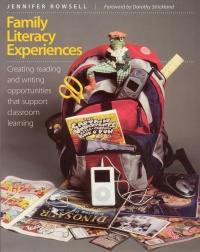| ________________
CM . . .
. Volume XIII Number 11 . . . .January 19, 2007 
 |
Family Literacy Experiences: Creating Reading and Writing Opportunities That Support Classroom Learning.
Jennifer Rowsell.
Markham, ON: Pembroke, 2006.
152 pp., pbk., $24.95.
ISBN 978-1-55138-707-4.
Subject Headings:
Family literacy programs.
Reading-Parent participation.
Language arts (Elementary).
English language-Study and teaching (Elementary).
Professional.
Review by Gregory Bryan.
*** / 4
|
| |
|

excerpt:
We need to view our students' literate lives outside of school as funds of knowledge that we can draw on and harness to our teaching.
The above extract succinctly states the premise of Jennifer Rowsell's book, Family Literacy Experiences. With that premise established, the text proceeds then to offer a potpourri of options teachers can use to effectively "harness" out of school literacy to in-school literacy. Written from a similar standpoint to David Booth's recent professional text, Reading Doesn't Matter Anymore, Rowsell adds her voice to the increasing clamour advocating multi-literacies and the need for educators to incorporate non-traditional literacy practices into our classroom instruction and learning.
One of many attractive features of Rowsell's book is her emphasis on the power of play and the central role of culture in literacy development. Rowsell's text is largely about how to use texts from the home in school, although it must be noted that she employs, and argues for, a liberal interpretation of "texts." Rowsell's texts embrace multi-literacies, New Literacy and multimodal literacy. A three-page glossary at book's end proves useful in defining some of the terms associated with this liberal interpretation of texts and literacy, offering definitions of terms such as zines, blogs, modes, synaesthesia and third spaces.
Family Literacy Experiences: Creating Reading and Writing Opportunities that Support Classroom Learning seeks to connect what interests students out of school to their in-school pursuits, establishing bridges to facilitate literacy success. One of the interesting angles that Rowsell pursues is inviting homes into schools. By this, she means incorporating things such as mass media, popular culture, household technologies and children's leisure pursuits into the classroom. She stresses the need to adjust our schools to fit students and their homes, rather than trying to change homes in order to fit schools. This is a subtle, but not insignificant switch in thinking, and it reflects greater sincerity in verbiage about valuing a learner and creating child-centred classrooms. One of the many benefits of the approach encouraged by Rowsell is that it offers greater potential to build authentic and positive relationships between homes and schools.
The book is divided into two parts. Part 1 is essentially theoretical in nature and establishes a framework for the material that follows in the second part. Part 2 seeks to present new texts and new skills associated with a new way of thinking about literacy. Much of the content in part 2 comes from the pen of other authors, providing a multitude of voices lending their support to this marriage of home literacy and school success. Part 2 abounds with information about classroom application of such things as newspapers, video games, the Internet, including the language of MSN, comic books, music and music videos, collector cards and television.
Information is readily accessible because of the liberal use of headings and subheadings, marginal notes, tables, the table of contents and a strong, detailed index. As far as the layout of the book, my one criticism is that most of the illustrative black and white photographs are too small and too dark and so serve little purpose other than to detract from the overall appeal of the publication.
Family Literacy Experiences offers a range of practical ways that teachers can use what students find exciting and motivational. It provides a means for teachers to recognize the diversity of literacy outside the classroom and to welcome that diversity into the classroom. As such, this book will add to the repertoire of most elementary and secondary teachers. This is a useful resource for teachers looking to embrace contemporary views of literacy, but who are desirous of assistance in doing so.
Recommended.
Gregory Bryan teaches literacy education courses at the University of Manitoba in Winnipeg, MB.

To comment
on this title or this review, send mail to cm@umanitoba.ca.
Copyright © the Manitoba Library Association. Reproduction for personal
use is permitted only if this copyright notice is maintained. Any
other reproduction is prohibited without permission.
NEXT REVIEW |
TABLE OF CONTENTS FOR THIS ISSUE
- January 19, 2007.
AUTHORS |
TITLES |
MEDIA REVIEWS |
PROFILES |
BACK ISSUES |
SEARCH |
CMARCHIVE |
HOME |
